Starting a project without clear objectives is like setting sail without a map – you might end up somewhere, but likely not where you intended. In today’s fast-paced work environment, defining clear project objectives isn’t just good practice, it’s essential for success.
This guide will break down exactly what project objectives are, why they’re crucial, how to write effective SMART objectives, and crucially, how a platform like monday.com can streamline the entire process.
Let’s dive in, and see how you can start defining objectives effectively today.
What are project objectives?
A project objective is the what, when, and why of every project — what is the project (action items), why are you doing it (desired result), and when does it need to happen (deadline).
So, what’s the difference between a project management objective and a goal?
That’s a frequently asked question and source of confusion.
Let’s settle it once and for all.
Project objectives vs. project goals
While different, project objectives and goals are essential to project planning and executing. Think about it like this:
- Goals are the general long-term outcome you want to achieve (seldom by one project alone).
- Objectives are the short to mid-term specific, measurable actions you take to help you achieve a goal.
For example:
- Goal — Increase annual recurring revenue (ARR).
- Objective — Increase qualified marketing leads by 20% each quarter.
- Goal — Improve your product’s user experience.
- Objective — Reduce the set-up process from 6 to 3 clicks by the end of the next development sprint.
Project objectives vs. project deliverables
Let’s drill down further.
- Objectives define the expected benefits, outcomes, and performance improvements from the project.
- Deliverables are the specific, tangible things you produce to achieve the objectives.
For example:
- Objective — Increase qualified marketing leads by 20% each quarter.
- Deliverable — Create a detailed sales plan with target customers and revenue per sales rep.
- Objective — Reduce the set-up process from 6 to 3 clicks by the end of the next development sprint.
- Deliverable — Complete usability testing session with at least 20 participants and deliver a findings report.
Read: Guide to setting goals at work
Project objectives vs. business objectives
Business objectives are the high-level, overarching aims of the entire organization (e.g., increase market share, improve profitability). Project objectives should always align with and contribute to these broader business objectives. A project objective focuses on the specific outcome of a single project, while a business objective looks at the bigger picture.
Project objectives vs. project scope
Project scope defines the boundaries of the project – what work is included and excluded. Project objectives define what the project aims to achieve within that scope. While related, the scope outlines the ‘how much’ and ‘what kind’ of work, whereas objectives define the ‘why’ and the desired results of that work. Poorly defined objectives often lead to scope creep.
Project objectives vs. project milestones
Project milestones are significant checkpoints or achievements within a project timeline, marking progress towards the objectives (e.g., ‘Phase 1 complete,’ ‘Prototype approved’). Objectives are the overall targets the project aims to hit, while milestones are the steps along the way used to track progress towards those objectives. Achieving all milestones should ideally lead to meeting the project objectives.
Why are clear project objectives crucial for success?
Defining clear project objectives isn’t just a formality; it’s fundamental to achieving project success. Here’s why they are so important:
Provide guidance and focus
Objectives act as a compass for the project team, ensuring everyone understands the target and works towards the same outcome. They prevent wasted effort on tasks that don’t contribute to the desired result.
Enable measurable outcomes and KPIs
Well-defined objectives are inherently measurable, allowing you to track progress using specific Key Performance Indicators (KPIs). This makes it possible to objectively determine if the project is on track and ultimately successful.
Improve stakeholder alignment
Clear objectives ensure all stakeholders (team members, management, clients) have a shared understanding of what the project aims to achieve, reducing misunderstandings and conflicts down the line.
Enhance decision-making
When faced with choices or changes during the project, objectives provide a clear framework for evaluating options. Decisions can be made based on whether they help or hinder the achievement of the stated objectives.
Prevent scope creep
Having clearly defined objectives helps to keep the project focused and resist the temptation to add features or tasks that aren’t aligned with the original purpose, thus preventing scope creep.
Types of project objectives
There are endless objectives that a project can have, all depending on your company department and industry,
so it’s helpful to categorize them into organized groups. By labeling each project with a broad category, you can apply a more holistic approach to your overall project management.
Here are six types of project objectives you can use:
1. Financial objectives
This type of objective typically focuses on how the project impacts the organization’s financial performance. However, as projects that make money cost money, it’s important to define a clear and measurable objective to achieve the target without losing sight of your costs.
For example: Launching a pay-per-click marketing campaign that will produce a 150% ROI (return on investment) within two months.
2. Quality objectives
This type of objective focuses on upgrading the quality of services or products delivered to customers to improve outcomes and get you closer to your business goals. Regulatory requirements and compliance objectives can also fit under this umbrella.
For example: Updating the payment page interface to reduce abandoned carts by 15% by the end of Q2.
3. Technical objectives
This type of objective focuses on improving overall project management and technical efficiency to streamline work processes and generate better results.
For example: Implementing a new work operating system across the company that will reduce repetitive tasks by 50% within two months.
4. Performance objectives
This type of objective focuses on improving products, services, or processes. It can help track resources, budget, and timeliness, and ensure your team reaches their target.
For example: Delivering a new company website within budget by the end of Q2.
5. Compliance objectives
This type of objective ensures projects adhere to regulations, procedures, and standards set by government or industry watchdogs.
For example: Build a new office that complies with the local authority’s health and safety guidelines.
6. Business objectives
This type of objective ensures any project aligns with the overarching company vision, values, and goals.
For example: Collect 10K new leads per month to increase annual recurring revenue (ARR).
Defining the category of each objective will ultimately make it easier to organize and prioritize company projects as well as track and manage objectives based on their grouping.
How to write effective project objectives (using the SMART framework)
Now for the part you’ve all been waiting for — the formula for writing project objectives.
While there are quite a few formulas, each with its own merits, we recommend using SMART objectives. It’s a standard project management framework for developing objectives and is the best way to deliver successful projects. SMART is an acronym for the five elements of the framework:
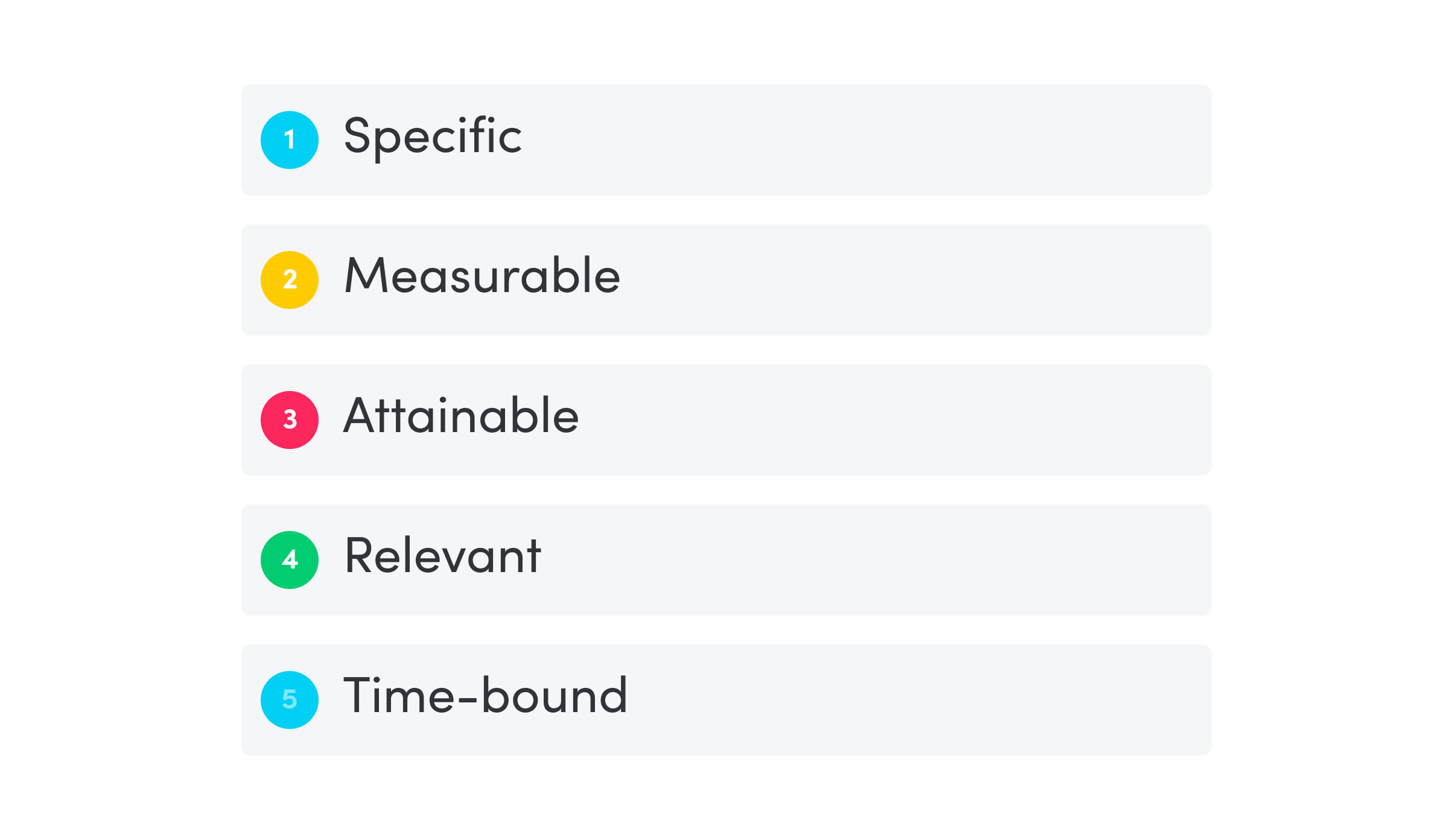
- Specific: Clearly define what you want to achieve. Who is involved? What are the constraints? Be precise.
- Measurable: How will you know when you’ve achieved the objective? Include metrics or KPIs to track progress and success.
- Attainable: Is the objective realistic given your resources, budget, and timeframe? Set challenging but attainable targets.
- Relevant: Does the objective align with broader project goals and business objectives? Ensure it contributes meaningfully to the overall vision.
- Time-bound: Every objective needs a target date or timeframe. When will it be completed? This creates urgency and allows for progress tracking.
Here’s how to write a SMART project objective:
1. Create your vision statement. Every project starts with a high-level company vision statement describing your business aspiration, which you might or might not achieve. The vision statement helps inform, inspire, and motivate your project team.
2. Outline your goals. Next, based on your vision, you can outline your goals. These are also broad and long-term, but help narrow the focus for your objectives. They provide the overall context for what the project should achieve.
3. State your project objectives. Finally, you can develop your objectives. Use the SMART framework to describe the actions required to achieve your goals and use our action plan template to put it all together in a plan.
Involve your team
Defining project objectives shouldn’t happen in a vacuum. The project manager cannot define objectives alone. Involve key team members and stakeholders in the process. Their input ensures objectives are realistic, well-understood, and have buy-in from those responsible for achieving them.
For example:
- Vision: Reach a broader, more inclusive audience.
- Goal: Launch a new accessible website.
- Objective: Develop and test the new website to comply with current web accessibility standards and make it live by the start of Q4.
Examples of SMART project objectives
Let’s look at some examples of SMART project objectives across different areas, incorporating some concepts from the previous types:
Marketing example
- Vision: Become the market leader in our niche.
- Goal: Increase brand visibility and engagement.
- Objective: Increase social media engagement (likes, shares, comments) on LinkedIn by 30% in Q3 by posting targeted content three times per week and running one targeted ad campaign focused on project managers.
New product example
- Vision: Create a new product.
- Goal: Successfully launch the new product feature
- Objective: Complete beta testing with 50 identified users and achieve an average satisfaction score of 8/10 by July 31st, incorporating feedback into the final release scheduled for September 1st.
Customer satisfaction example
- Vision: Provide world-class customer support.
- Goal: Improve customer satisfaction ratings.
- Objective: Reduce average customer support ticket resolution time from 48 hours to 24 hours within the next six months by implementing a new knowledge base and providing additional training to support staff by end of Q2.
Business/Financial example
- Vision: Achieve sustainable profitability.
- Goal: Increase annual recurring revenue (ARR).
- Objective: Secure contracts with 15 new enterprise clients, generating an additional $500,000 in ARR by the end of the fiscal year, through targeted outreach by the sales team based on the new ICP definition.
Technical/Process Improvement example
- Vision: Operate with maximum efficiency.
- Goal: Streamline internal workflows.
- Objective: Reduce the time required for the monthly financial reporting process by 20% (from 5 days to 4 days) by the end of Q4 through the implementation and adoption of the new automation features within our work management platform.
Need a place to organize your project objectives? We got you covered.
Common mistakes to avoid when setting project objectives
While the SMART framework helps, teams can still stumble. Here are common pitfalls to watch out for during objective setting:
Being too vague or broad
Objectives like “Improve customer satisfaction” or “Increase sales” lack specificity and measurability. Ensure objectives clearly state what success looks like.
Forgetting measurability (No KPIs)
If you can’t measure it, you can’t manage it or know if you’ve achieved it. Every objective needs clear metrics or KPIs associated with it.
Setting unrealistic targets
While ambition is good, objectives must be achievable. Setting impossible targets demotivates the team and sets the project up for failure. Consider resources, time, and potential risks.
Poor alignment with goals
Objectives must directly contribute to broader project and business goals. An objective achieved in isolation that doesn’t move the needle on strategic goals is wasted effort.
Confusing objectives with tasks or deliverables
Remember, objectives are the outcomes you want to achieve, not the tasks you perform. Focus on the ‘why’ and the result.
How monday.com helps you define, track, and achieve project objectives
Setting SMART objectives is crucial, but tracking and managing them effectively requires the right platform. monday.com provides a centralized Work OS to define, visualize, track, and report on your project objectives seamlessly.
Centralize objective planning with monday docs and boards
Use monday boards to list your project objectives, assign owners, set deadlines, and link them directly to related tasks or deliverables. Utilize monday docs to collaboratively draft and finalize objective statements, keeping all planning documentation in one place.
Visualize progress with dashboards and custom views (Gantt, Kanban)
- Project views: Choose from 15+ board views like Gantt, Kanban, Timeline, and Chart views to visualize objective timelines, dependencies, and progress in the way that makes most sense for your team. Track objectives alongside tasks and milestones.
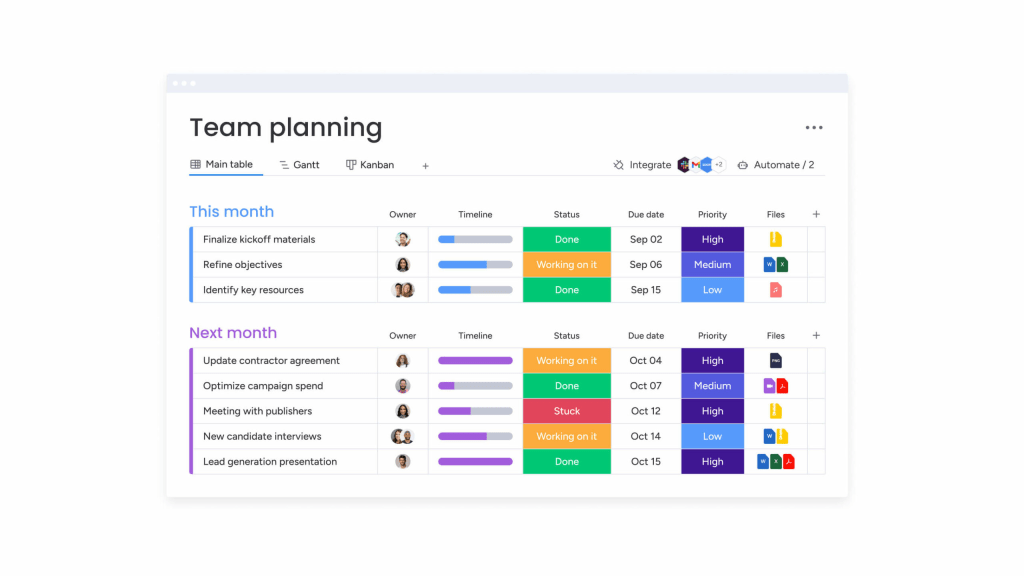
- Dashboards: Create custom dashboards pulling real-time data from your project boards. Use widgets like charts, progress bars, and number widgets (choose from 10+ options) to display KPIs related to your objectives, providing stakeholders with instant visibility.
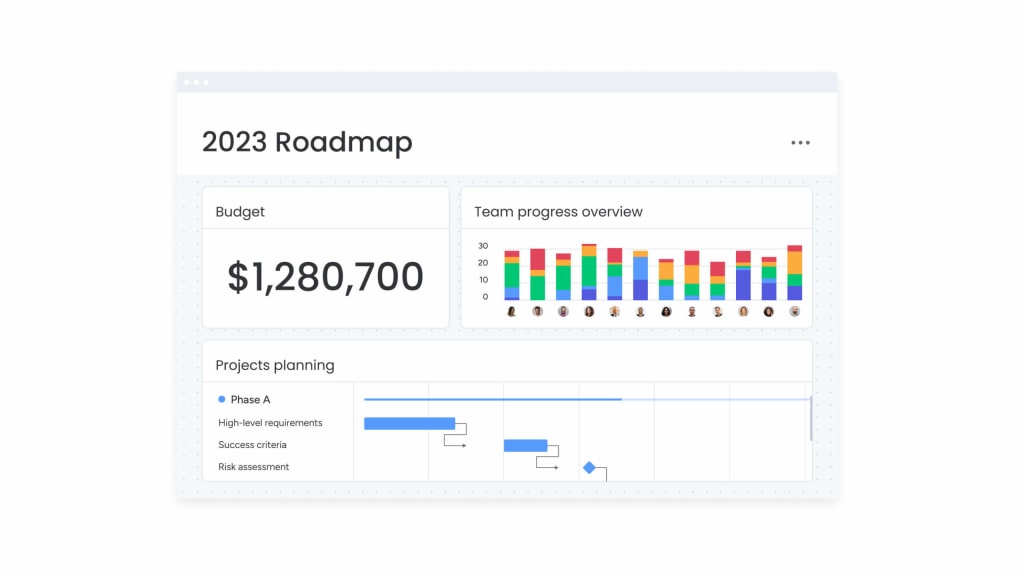
Ensure alignment with goal tracking features
Utilize monday.com’s goal-setting features to link project objectives directly to departmental or company-wide goals, ensuring strategic alignment and demonstrating project impact.
Automate updates and reporting
- Automations: Set up automations to notify stakeholders when objectives are at risk, milestones are met, or deadlines are approaching. Reduce manual updates and keep everyone informed effortlessly. Use project templates to standardize objective setting across projects.
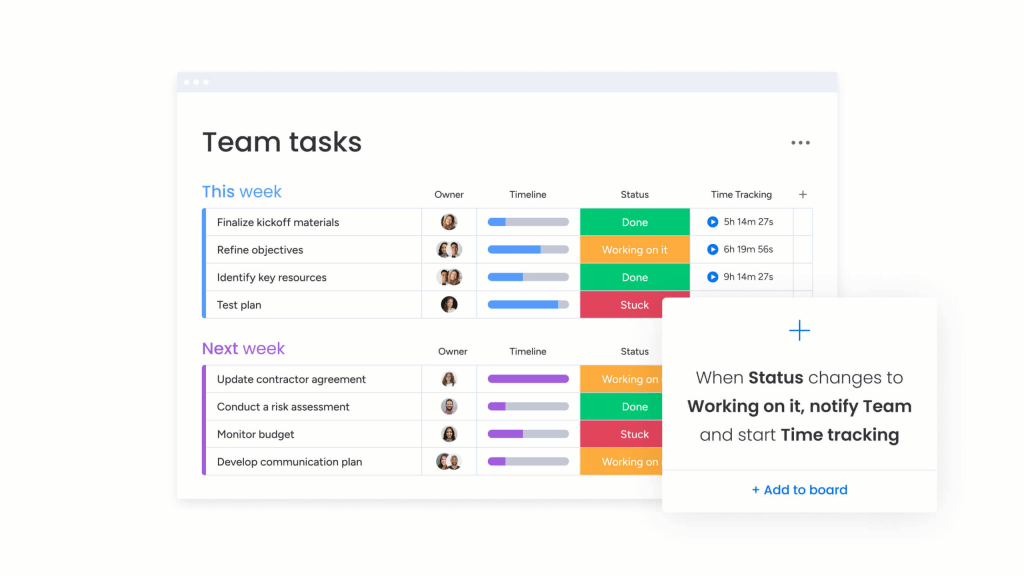
Integrate with your existing tools
- Integrations: Connect monday.com with tools like Slack, Jira, Salesforce, Microsoft Teams, and more. Pull data relevant to your objectives from other platforms or push updates, creating a single source of truth for project progress.
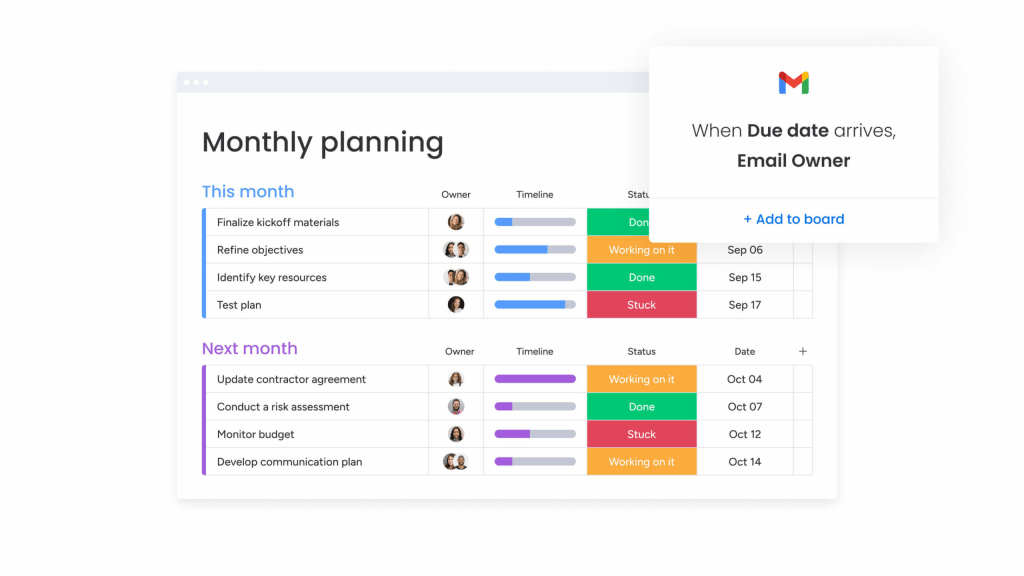
Start achieving your project objectives with monday.com
Well-defined project objectives are the bedrock of successful project execution. They provide clarity, focus, and measurability, transforming vague intentions into actionable targets.
By using the SMART framework and avoiding common pitfalls, you set your projects up for success from the start. Aligning these objectives with broader goals ensures your team’s efforts contribute directly to the company’s vision.
Ready to move from planning to achieving? monday.com provides the tools you need to define, track, and accomplish your project objectives efficiently. Centralize your planning, visualize progress, automate updates, and ensure everyone is aligned towards success.
FAQs
What defines smart project objectives?
SMART project objectives are Specific (clear, unambiguous), Measurable (quantifiable, trackable with KPIs), Achievable (realistic given resources), Relevant (aligned with project/business goals), and Time-bound (having a defined deadline).
Are project objectives and project goals the same?
No, project objectives and project goals are different but essential elements used in project planning and execution. Project goals are the general long-term outcome you want to achieve, while project objectives are the specific, measurable, short- to mid-term actions required to achieve a goal.
What questions do project objectives answer?
Project objectives answer the what, why, and when questions of every project. For example:
What is the specific desired outcome of the project?
Why are we undertaking this project (what's the benefit/result)?
When does it eed to be completed by?
How will we measure success (what KPIs)?
How do project objectives relate to KPIs?
Project objectives define what you want to achieve, while Key Performance Indicators (KPIs) are the metrics used to measure progress towards those objectives. For every measurable objective, you should identify one or more KPIs to track. For example, if the objective is "Increase website conversion rate by 10% in Q3," the KPI is the website conversion rate.
What are the most common mistakes when writing project objectives?
The most common mistakes include being too vague, forgetting measurability (no KPIs), setting unrealistic targets, poor alignment with overall goals, and confusing objectives with tasks or deliverables. Using the SMART framework helps avoid these pitfalls.
Can project objectives change during a project?
While objectives should provide stability, they can sometimes change due to significant shifts in the business environment, project scope, or strategy. However, any changes should go through a formal change control process, be carefully evaluated for impact, and communicated clearly to all stakeholders.
How does monday.com help align objectives with overall business goals?
monday.com allows you to link project objectives directly to higher-level company or departmental goals using dedicated goal-tracking features. This visual connection helps teams understand how their project contributes to the bigger picture and allows leadership to see how strategic goals are progressing based on project outcomes.

